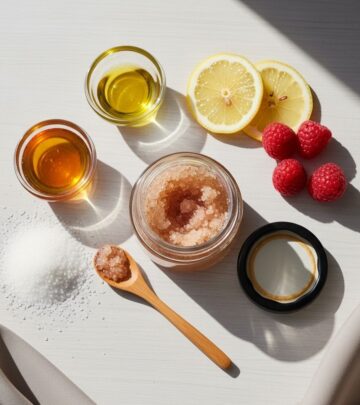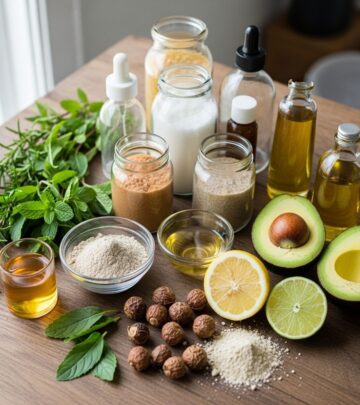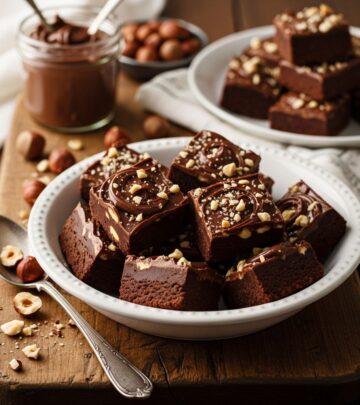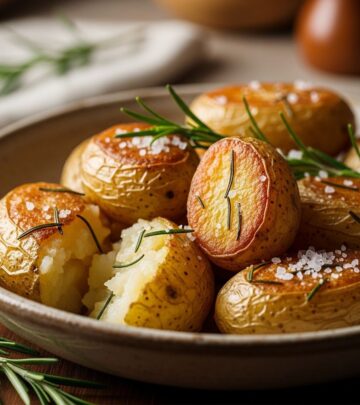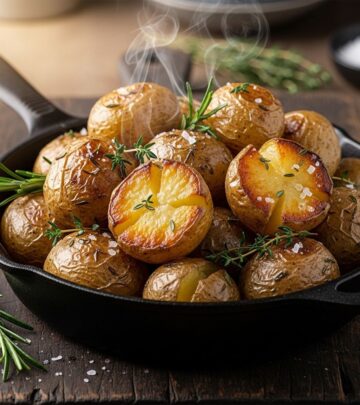Baked Acorn Squash Recipe: Easy Brown Sugar & Butter Side Dish
Sweetly roasted autumn treat blending rich flavors in a cozy, melt-in-mouth delight.
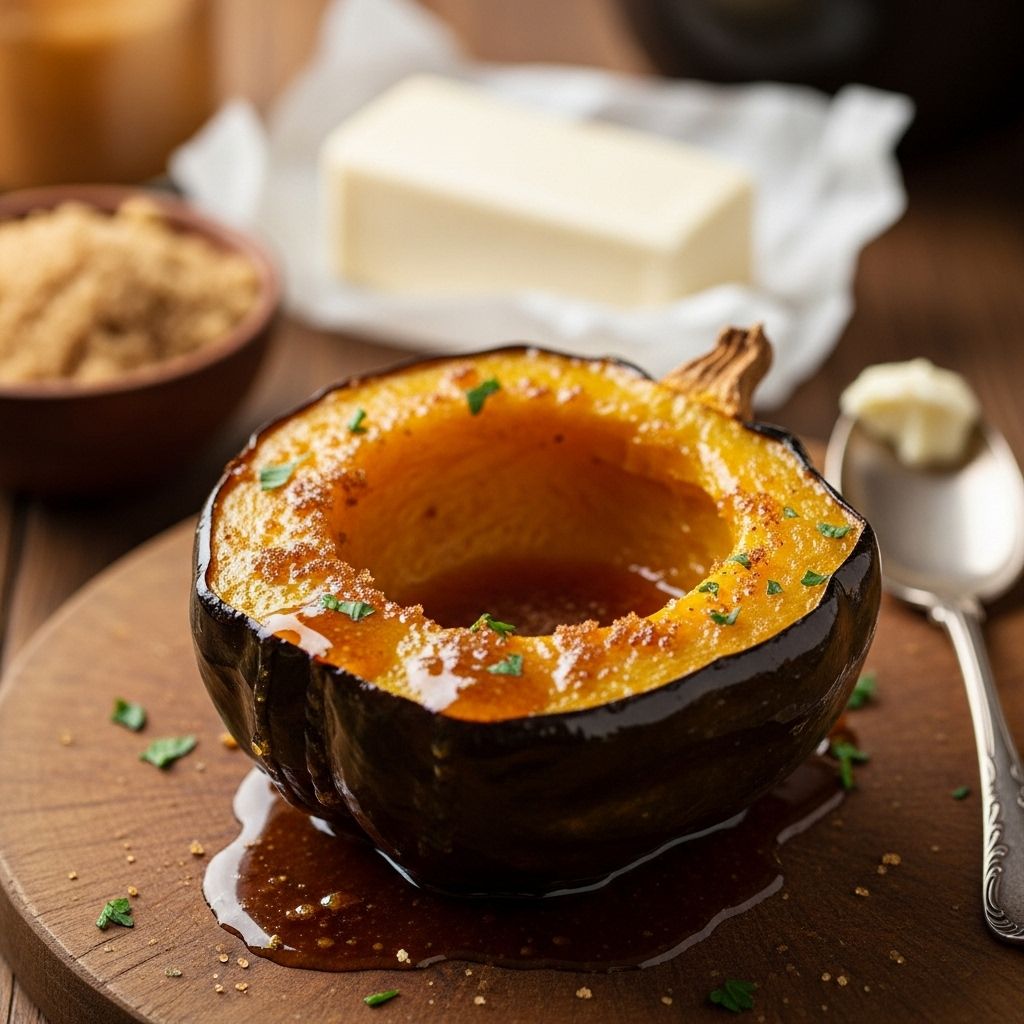
Image: HearthJunction Design Team
Delicious Baked Acorn Squash with Brown Sugar and Butter
When autumn arrives and winter squashes appear at farmers’ markets and grocery stores, acorn squash stands out as one of the most versatile and delicious options. With its distinctive ribbed exterior and sweet, nutty flavor, acorn squash makes an excellent side dish that pairs beautifully with roasted meats, holiday meals, or even as a standalone vegetarian option. This classic baked acorn squash recipe combines the natural sweetness of the squash with brown sugar and butter for a dish that’s both comforting and impressive.
What is Acorn Squash?
Acorn squash is a winter squash variety known for its distinctive acorn-like shape and deep ridges. The exterior typically displays a dark green skin, sometimes with orange patches, while the interior reveals a vibrant yellow-orange flesh. As part of the Cucurbitaceae family, acorn squash is related to other winter squashes like butternut, delicata, and spaghetti squash.
Unlike summer squashes that have tender skins and shorter shelf lives, acorn squash features a harder exterior that helps preserve it through the colder months. This makes it an excellent storage vegetable that ancient civilizations relied on for sustenance during winter. The flesh is less fibrous than some other winter squash varieties, with a mild, subtly sweet flavor that becomes even more pronounced when roasted.
Nutritionally, acorn squash is a powerhouse. It contains significant amounts of vitamin C, potassium, and fiber, along with various antioxidants and other beneficial nutrients. Its natural sweetness makes it particularly appealing when paired with complementary flavors like the brown sugar and butter featured in this recipe.
Ingredients for Baked Acorn Squash
This simple yet delicious recipe requires just a handful of ingredients that you likely already have in your pantry. Here’s what you’ll need:
- 1 acorn squash
- 2 tablespoons butter
- 2 tablespoons brown sugar
- 2 teaspoons maple syrup (optional)
- Salt and pepper to taste
The beauty of this recipe lies in its simplicity. The brown sugar caramelizes during baking, creating a sweet glaze that perfectly complements the natural flavor of the squash. Butter adds richness and helps the brown sugar melt into a delicious syrup that infuses the squash as it bakes.
If you’d like to add additional flavors, consider incorporating a pinch of cinnamon, nutmeg, or a dash of cayenne pepper for a sweet-heat combination. Some home cooks also enjoy adding a splash of maple syrup for an extra layer of flavor complexity.
Tools and Equipment Needed
Preparing acorn squash is straightforward and requires minimal equipment. Here’s what you’ll need to have ready:
- A sharp chef’s knife for cutting the squash
- A sturdy spoon for removing seeds
- A baking sheet or shallow baking dish
- Aluminum foil (optional, for easier cleanup)
- Measuring spoons
- Oven mitts
Safety tip: Acorn squash has a tough exterior that can be challenging to cut through. Always use a sharp knife and work on a stable surface. Some cooks find it helpful to microwave the whole squash for 2-3 minutes before cutting to slightly soften the skin.
Preparation Steps
Before diving into the cooking process, proper preparation ensures your acorn squash will cook evenly and taste its best:
- Wash the exterior of the squash thoroughly under cool running water to remove any dirt or debris.
- Pat dry with a clean kitchen towel.
- Place the squash on a cutting board with the stem side down for stability.
- Carefully cut the squash in half from top to bottom (stem to end).
- Using a sturdy spoon, scrape out the seeds and stringy pulp from the center cavity of each half. (Don’t discard the seeds—they can be roasted separately for a nutritious snack!)
- If the halves wobble on your cutting board, you can trim a small slice from the bottom of each half to create a flat, stable surface.
Now your acorn squash is ready for seasoning and baking. This preparation ensures the butter and brown sugar will stay in place during cooking, creating that wonderfully sweet and buttery flavor that makes this dish so popular.
Detailed Cooking Instructions
Follow these step-by-step instructions for perfectly baked acorn squash every time:
- Preheat your oven to 400°F (200°C) to ensure it reaches the proper temperature before baking.
- Place the prepared squash halves cut-side up on a baking sheet or in a baking dish. If using foil for easier cleanup, line your baking surface first.
- Place 1 tablespoon of butter in the hollow of each squash half.
- Sprinkle 1 tablespoon of brown sugar over the butter in each half.
- If using maple syrup, drizzle 1 teaspoon over each half.
- Season with a small pinch of salt and pepper to taste.
- Flip the squash halves so they’re now cut-side down on the baking sheet. This allows the squash to steam slightly while roasting, resulting in perfectly tender flesh.
- Place the baking sheet in the preheated oven and bake for approximately 30 to 45 minutes. The exact time will depend on the size of your squash and your oven’s particular characteristics.
- Check for doneness by carefully flipping one half and piercing the flesh with a fork. The squash is done when the flesh is easily pierced and feels tender throughout.
- Once done, remove from the oven and carefully flip the halves back to cut-side up. The butter and brown sugar will have created a delicious syrup in the cavity.
- Allow to cool slightly before serving, about 5 minutes.
For a caramelized finish, you can place the squash under the broiler for the final 2-3 minutes of cooking time. Just be sure to watch it carefully to prevent burning.
Serving Suggestions
Baked acorn squash makes a versatile and beautiful addition to many meals. Here are some serving ideas to make the most of this delicious dish:
- Serve each half as an individual portion alongside roasted chicken, turkey, or pork.
- For a vegetarian main dish, fill the cavity with a mixture of cooked quinoa, cranberries, and toasted pecans.
- Cut each half into wedges after baking for a more elegant presentation at dinner parties.
- Scoop the flesh out of the skin and mash with a fork for a simpler presentation, similar to mashed sweet potatoes.
- For a savory variation, replace the brown sugar with grated Parmesan cheese and herbs like thyme and rosemary.
The natural bowl shape of acorn squash halves makes them perfect vessels for creative fillings. Consider stuffing them with wild rice, sautéed mushrooms, or even a hearty chili for a complete meal in an edible container.
Nutritional Information
Acorn squash isn’t just delicious—it’s also packed with nutrients. While the addition of butter and brown sugar increases the calorie content, the dish remains relatively nutritious. Here’s an approximate nutritional breakdown per serving (half a squash with butter and brown sugar):
| Nutrient | Amount |
|---|---|
| Calories | ~200-250 |
| Carbohydrates | ~30g |
| Fat | ~12g |
| Protein | ~2g |
| Fiber | ~5g |
| Vitamin A | ~20% DV |
| Vitamin C | ~25% DV |
| Potassium | ~15% DV |
For a lower-calorie option, you can reduce the amount of butter and brown sugar or substitute with alternatives like a light drizzle of honey or maple syrup and a smaller amount of butter or olive oil.
Storage and Reheating Tips
Baked acorn squash can be prepared ahead of time and reheated, making it perfect for busy weeknights or holiday meal prep. Follow these storage guidelines:
- Refrigeration: Store cooled leftover squash in an airtight container for up to 3-4 days.
- Freezing: Scoop the cooked flesh from the skin and store in freezer-safe containers for up to 3 months. The texture may change slightly upon thawing.
- Reheating: Warm refrigerated squash in a 350°F oven for about 15-20 minutes, or microwave individual portions for 1-2 minutes.
For best results when reheating, add a small pat of fresh butter on top to restore some of the richness that might have been absorbed during storage. If the squash seems dry, a small splash of apple cider or orange juice can rejuvenate it.
Variations and Creative Twists
While the classic brown sugar and butter combination is delicious, there are countless ways to customize this basic recipe:
- Savory Version: Replace the brown sugar with Parmesan cheese, herbs like thyme and sage, and a drizzle of olive oil.
- Spiced: Add warm spices like cinnamon, nutmeg, allspice, and a pinch of cloves to the brown sugar mixture.
- Stuffed: Fill the cavity with a mixture of cooked sausage, apple, and sage for a hearty main dish.
- Maple Pecan: Use maple syrup instead of brown sugar and top with chopped toasted pecans during the last 10 minutes of baking.
- Coconut: Replace the butter with coconut oil and sprinkle with unsweetened coconut flakes for a tropical twist.
Don’t be afraid to experiment with your favorite flavors. The mild, slightly sweet nature of acorn squash provides an excellent canvas for both sweet and savory ingredients.
Frequently Asked Questions (FAQs)
Q: How do I select the best acorn squash at the store?
A: Look for acorn squash that feels heavy for its size with dull, dark green skin (sometimes with an orange patch where it rested on the ground). The squash should be free of soft spots, and the stem should be firmly attached. A fully mature acorn squash will have a hard, rigid exterior that cannot be easily pierced with a fingernail.
Q: Can I eat the skin of acorn squash?
A: Yes, the skin of acorn squash is technically edible when cooked until tender. However, many people prefer to eat just the flesh, as the skin can remain somewhat tough even after cooking. If you do choose to eat the skin, be sure to wash the exterior thoroughly before cooking.
Q: How can I make cutting the squash easier?
A: Cutting acorn squash can be challenging due to its hard exterior. To make it easier, microwave the whole squash for 2-3 minutes first to slightly soften the skin. Always use a sharp chef’s knife and a stable cutting surface. Some cooks also find it helpful to use a rubber mallet to gently tap the knife through particularly tough spots.
Q: Can I make this recipe vegan?
A: Absolutely! Simply substitute the butter with coconut oil, olive oil, or a vegan butter alternative. The brown sugar is already vegan-friendly, but you could also use pure maple syrup as a sweetener instead.
Q: How do I know when my acorn squash is perfectly done?
A: Properly cooked acorn squash should be easily pierced with a fork throughout the flesh. The flesh should be tender but not mushy. Depending on the size of your squash and your oven, this typically takes between 30-45 minutes at 400°F.
Q: Can I cook acorn squash in the microwave?
A: Yes, for a quicker cooking method, place prepared squash halves cut-side down in a microwave-safe dish with about 1/4 inch of water. Microwave on high for 10-12 minutes, or until tender. Then add the butter and brown sugar and microwave for an additional 2 minutes. The texture won’t be quite the same as oven-baked, but it works well when time is limited.
This sweet and satisfying baked acorn squash recipe offers the perfect balance of simplicity and flavor. Whether serving it as part of a holiday feast or as a nutritious side dish for a weeknight dinner, it’s sure to become a favorite in your recipe collection. The natural sweetness of the squash enhanced by brown sugar and rich butter creates a dish that feels indulgent while still delivering valuable nutrients—truly the best of both worlds.
References
- https://www.allrecipes.com/recipe/16796/acorn-squash/
- https://www.allrecipes.com/recipe/280952/roasted-acorn-squash-with-brown-sugar/
- https://www.allrecipes.com/article/best-acorn-squash-recipes/
- https://www.allrecipes.com/recipe/14083/roasted-acorn-squash/
- https://www.allrecipes.com/recipe/232280/parmesan-roasted-acorn-squash/
Read full bio of Shinta


